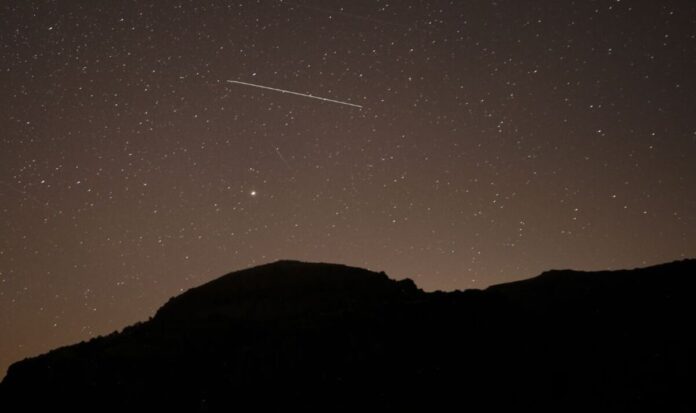Stargazers may get a treat later this week, weather permitting, with the Leonids meteor shower expected to peak over Thursday night and Friday morning. The spectacle, which occurs every November, is triggered by Earth’s proximity to the path of the comet 55P/Tempel–Tuttle. As the comet travels around the Sun, it leaves tiny bits of debris, some no bigger than a grain of sand, in its wake. When these enter the Earth’s atmosphere at speeds of up to 44 miles per second they burn up, putting on a light show. In fact, according to NASA experts, the Leonids are among the fastest meteor showers known. Astronomers have determined that the nucleus of comet 55P/Tempel–Tuttle is relatively small, ast around only 2.2 miles across. This is comparable to the size of the island of Manhattan in New York.A spokesperson for the Royal Museums Greenwich said: ‘The Leonids are usually one of the more prolific annual meteor showers, with fast, bright meteors. This year, they added, ‘the Leonid meteor shower will peak on 17–18 November between midnight and dawn.’The annual meteor shower takes its name from the fact that its ‘radiant’ lies within the constellation of Leo. The radiant is the point in the sky from which they appear to originate.Although the peak will occur on Thursday night, they can typically be seen between around 6–30 November. However, they will be more intermittent in this period.The show put on by the Leonids is also more impressive roughly every 33 years – corresponding to the period of the comet 55P/Tempel–Tuttle – when they generate so-called meteor storms. During these events, one can see hundreds or even thousands of shooting stars. Stargazers may get a treat this week, with the Leonids meteor shower peaking Thursday night (Image: Getty Images) The annual meteor shower takes its name from the fact that its radiant lies within Leo (Image: Royal Museums Greenwich )The last meteor storms from the Leonids occurred in the years 1999–2001, when onlookers were able to witness some 3.000 meteors each hour.According to astronomers, the storm in 1833 was ‘particularly spectacular’, with a whopping 100,000 shooting stars estimated to have been visible each hour. The next meteor storm from the Leonids is expected to occur in the year 2033.Another ‘spectacular’ Leonid storm occurred in 1966, according to NASA. They said: ‘Thousands of meteors per minute fell through Earth’s atmosphere during a 15-minute period. There were so many […] that they appeared to fall like rain.’Weather permitting, the best views of this year’s light show will be had in locations with clear skies, and far away from sources of light pollution like big cities. The shooting stars should be visible to the naked eye, without need for binoculars or a telescope.READ MORE: NASA rocket live stream – where you can watch Artemis launch tomorrow Unfortunately, the Met Office are predicting extensive cloud cover on Thursday night (Image: Met Office) The storm in 1833 was ‘particularly spectacular’. with some 100,000 meteors each hour (Image: Public Domain / Adolf Vollmy)Unfortunately, viewing conditions on Thursday night may not be optimum for stargazing. In fact, the Met Office forecast predicts cloudy skies across much of the UK.Viewers close to the South East coastline may have the clearest views. Patchy skies are also predicted for Cornwall, Devon and parts of Pembrokeshire in Wales.According to the Met Office, the UK’s outlook for Thursday through Saturday, in fact, is ‘changeable with further spells of sometimes heavy rains at times, interspersed with brighter, showery interactions.In addition, a yellow warning is in effect on Thursday evening for parts of the south-east. The Met Office has noted that ‘heavy rain and showers [will bring] a chance of some flooding and disruption’ – a forecast that bodes poorly for a good meteor shower viewing experience.DON’T MISS:World hits 8bn people as countries with biggest populations unveiled [REPORT]Rishi Sunak urged to ‘immediately’ scrap heat pump payment scheme [INSIGHT]Study claims French people locked in ‘laziness epidemic’ [ANALYSIS] The Leonids are meteors from the comet 55P/Tempel–Tuttle (Image: Express.co.uk)The Royal Museums Greenwich said: ‘Hunting for meteors, like the rest of astronomy, is a waiting game. It’s best to bring a comfy chair to sit on and to wrap up warm, as you could be outside for a while.’You will need to allow your eyes to adjust to the dark. The meteors can be seen in all parts of the sky, so it’s good to be in a wide open space where you can scan the night sky with your eyes.’If you miss the peak, the shower continues at a reduced rate for several days either side. There should be plenty of chances to see the display.’After the Leonids, there will be two more notable meteor showers this year. These are the Geminids, which are expected to peak on December 14–15 and the Ursids, which will peak on 22–23 December.
Look up this week as the Leonids meteor shower to peak Thursday night
Sourceexpress.co.uk
RELATED ARTICLES


